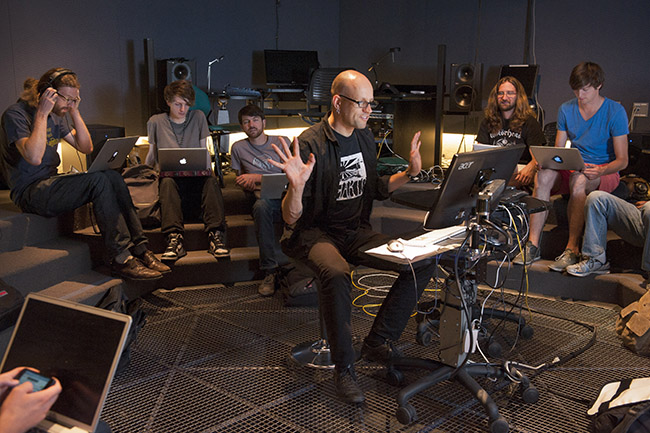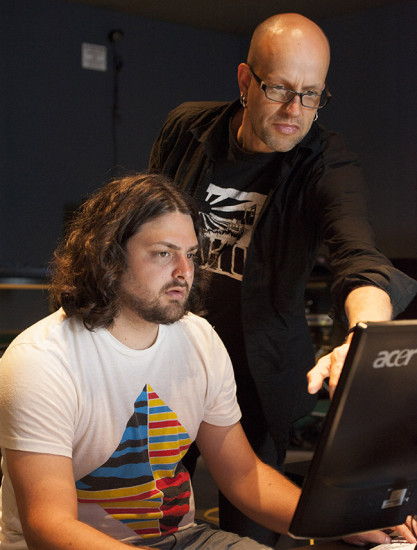
Digital musician Robert Henke, center, in his class 'Music 223M: Sound, Structure, and Machines.' On Thursday and Friday Henke will present Stanford Dust at Bing Concert Hall Studio as the culmination of his time as Stanford's 2013 Mohr Visiting Artist.
L.A. CiceroStanford visiting artist Robert Henke to perform a ‘musical machine’
Musician Robert Henke, Stanford's 2013 Mohr Visiting Artist, will perform a computer-driven musical performance Thursday and Friday at Bing Concert Hall Studio. The piece, called Stanford Dust, comprises sounds Henke recorded at and around Stanford.
Digital musician Robert Henke is building a musical performance without performers. Seated in a thick darkness, the audience will be surrounded by morphing and transforming sounds unlike anything typically heard in a concert hall.
This Thursday and Friday Henke will present Stanford Dust at Bing Concert Hall Studio as the culmination of his time as Stanford’s 2013 Mohr Visiting Artist. Henke relates the show’s unique experience to watching a sunset in the desert.
“At the first glance not much change is going on; it has lots of detail, but it seems to be very static,” he said. “The more time passes and the closer you look the more you notice things are changing. That’s the pace I’d like to achieve with the Dust piece – a state of immersion into a large mess of intricate sounds.”

The Thursday performance of Stanford Dust begins at 8 p.m. and the Friday performance begins at 9 p.m., both at Bing Concert Hall Studio. Tickets are available online for $10 each.
Dust and digital
The sounds of Stanford Dust may strike a familiar chord for Stanford residents. Henke recorded sounds at and around Stanford’s Center for Computer Research in Music and Acoustics (CCRMA).
Many of the sources of sounds – such as coffee makers, printers, gas canisters and shutting doors – might seem odd in a musical performance. Henke said he simply looked for things that sounded interesting. Even the bells in Stanford’s iconic Hoover Tower might make an appearance, he said.
For me, these projects aren’t amazing because they’re so complex, but because you come in and you think, ‘Wow, this succession of events is beautiful – this touches me.’
Henke, a professor of sound design at the Berlin University of the Arts, has a long history of using abstract and completely digital sounds in his pieces. His original Dust piece included ocean waves striking a pebble-filled beach in Australia and the hum of an electrical transformer alongside sounds created entirely by mathematical functions.
“Making music with computers to a large extent is a technical process,” said Henke. “But the technical side is not a guarantee of an artistic outcome. It’s easy to create a complex system that doesn’t touch you and isn’t inspiring.”
Musical machine
As part of the Mohr Visiting Artist Program, Henke is working with several Stanford students to perform a digital “music machine.” The currently untitled project combines math, music and engineering in randomly evolving sequences of sound.
“So many fields work together to enable this artistic expression,” said Henke. “The question of what we want to achieve artistically can’t be answered by the technology; the instrument alone is not artwork.”
The 18 students will present their piece during the CCRMA Spring Concert, which takes place in Bing Concert Hall Studio on May 28 at 8 p.m. and is free to the public. The “machine” is built out of musical parts, each interacting with one another.

“It’s something between installation and concert,” said Henke. “It has the properties of an installation since it’s meant to run by itself, but there is still the option to interact with the process and become the conductor of the machine.”
The performance will take advantage of the surround-sound system at Bing Concert Hall Studio. According to Henke, at one point during the performance the sound will settle near a player piano, which will join in and play with the rest of the music.
However, Stanford Dust and the student projects are not simply showcases of audio technological feats. As with all art, the goal of the performances is a connection with the audience, said Henke.
“For me, these projects aren’t amazing because they’re so complex, but because you come in and you think, ‘Wow, this succession of events is beautiful – this touches me,'” said Henke. “There’s an emotional component to it.”
